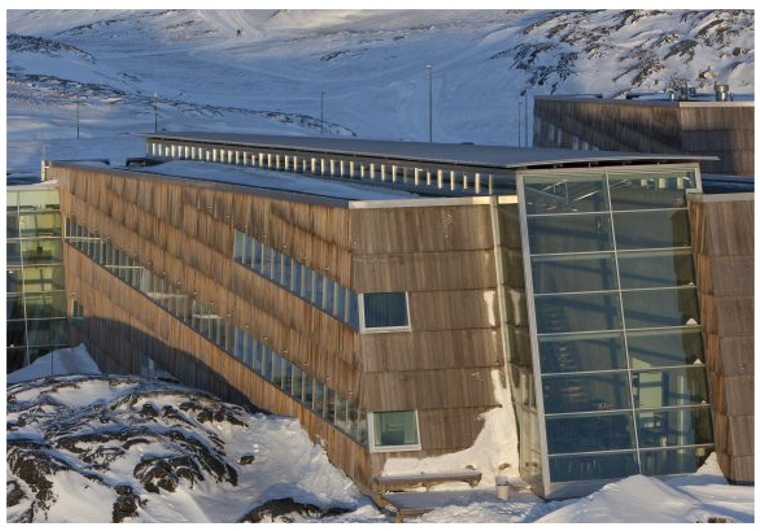Greenland Institute of Natural Resources, GL (DK)

Greenland Institute of Natural Resources, GL (DK)
The research infrastructure is owned by the Government of Greenland.
GINR was founded in 1995 (preceded by Greenland Fisheries Research; established in 1946), and the main building was inaugurated in 1998.
Research and monitoring activities at GINR focus on living marine resources (fish, shellfish, marine mammals, and birds), land-based resources (land mammals and vegetation) as well as physical and chemical processes in the environment in relation to climate change and its impact on society. GINR has ca. 5000 m2 under roof and provides access to several lab facilities, freezers, offices, auditorium, classrooms, and accommodation.
Contribution to POLARIN key research challenges: 1, 2, 3, 4, 5, 6, 7
Contact: Station manager Katrine Raundrup kara[at]natur.gl
Website
https://interact-gis.org/Home/Station/73
Location
The Greenland Institute of Natural Resources (GINR) with its main buildings, laboratories, and living quarters is located in Nuuk, Greenland (64°11’ N, 51°41’ W).
A field station is located in Kobbefjord (64°08’ N, 51°23’ W), c. 25 km southeast of Nuuk.
Facilities
The main facility of c. 3000 m2 hosts offices, laboratories, deep-freeze rooms, storage, conference room, and meeting rooms. Adjacent to the main building is an 850 m2 annex with a large multi-room used for meetings and seminars, five apartments and eight rooms for visiting researchers, as well as a garage/storage room.
GINR has a third building near the city centre of Nuuk with furnished guest rooms for students and visiting scientists. In addition to the buildings in Nuuk, GINR owns two field stations, one in Kobbefjord, near Nuuk, and another in Niaqornat, in the Uummannaq area, Northwest Greenland.
The field stations function as bases for small research teams and accommodates four people each. GINR owns two research vessels, Sanna and Tarajoq, which are used for scientific investigations in both sheltered and open waters. Also, the institute has several small boats and aluminium dinghies. For transport on land, GINR owns four cars and several snowmobiles.
Services offered
GINR main facility and its field station in Kobbefjord provide access to a low Arctic ecosystem in West Greenland with different biotopes such as dwarf-shrub heaths, fens, grasslands, and lakes. A monitoring programme on vegetation, arthropods, mammals, birds, lakes, and the marine environment has been carried out at GINR for several years. This long-term monitoring programme GEM operates at the field station in Kobbefjord (www.g-e-m.dk ).
What is included in the Access
Unit of access: User/day
Modalities of access offered: In-person access, remote access
Use of the facilities and accommodation at the GINR main facility and/or Kobberfjord field station, Transport to and from the Kobbefjord field station (ca. 30 min boat ride from Nuuk). The typical duration of work is between 1 and 2 weeks. The users are fully independent in implementing their project and their visit will be integrated into the general schedule of GINR and the field station.
Availability for Access
See the table in the dedicated Transnational Access call page.
Time frame for access preparations
Users granted access must provide an application form including practical information about their stay (accommodation booking etc.) to GINR. The form can be obtained from the GINR contact person.
If users are shipping field equipment, they will have to ship (from Denmark) no later than 4 weeks before they plan to use it in Nuuk
Permits, licenses and training
Required permits depend on the work to be carried out.
The Government of Greenland requires different permits if the users collect “genetic material” or “soil/sediments/rocks”, and an ethical board in Greenland will handle applications when the studies involve people.
GINR recommends that users have updated First Aid training. If users are going to the field station in Kobbefjord, it is recommended to have riffle training before arrival.
Medical guidelines
No specific medical guidelines.